|
Seems like everything wants to keep on keeping on...
|
Now lets extend our understanding of translational motion by
defining a new term, "linear momentum". Linear momentum
of a particle is the product of a particle's mass and its
velocity. For some reason which escapes me at the moment, the
symbol p is customarily used to designate momentum.
Since it is the product of a vector and a scalar, it is a vector
quantity,
p = m * v.
The rate of change of momentum with respect to time, taking mass
to be constant, is
p' = m * v',
where v' is the vector acceleration of the particle.
Remember that we are using the ' symbol to represent the rate
of change with respect to time. From our expression of
Newton's second law, we know that m * v' is the
force on a particle so
p' = f.
In fact when Newton published his second law it was in the form
p' = f, rather than as we first expressed
it.
For a system of particles, the linear momentum is just the vector
sum of that of each of the particles individually. As we worked
out in the previous lesson,
m * vcm =
m1*v1 +
m2*v2...+
mn*vn
so for a system of particles
p = m * vcm,
and
p' = m * acm
= fa,
where fa is the force resultant external
force applied to the particles.
In words this says that for a
system of particles, the rate of change of the total momentum is
equal to the applied force. Run the
Two Particle Center of Mass
display again and look at the center of mass track. Since the objects are moving with constant
velocity we know that there is no force applied to the two object
system. The momentum of the whole system must be constant,
meaning that the center of mass travels in a straight line at
constant velocity.
|
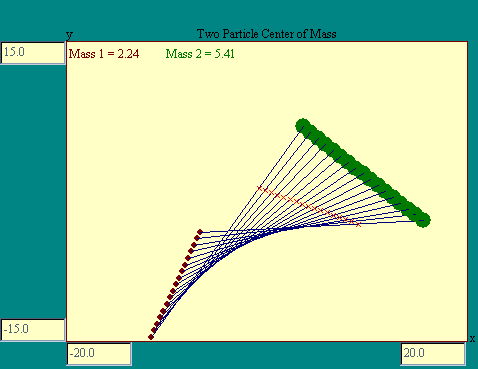
|
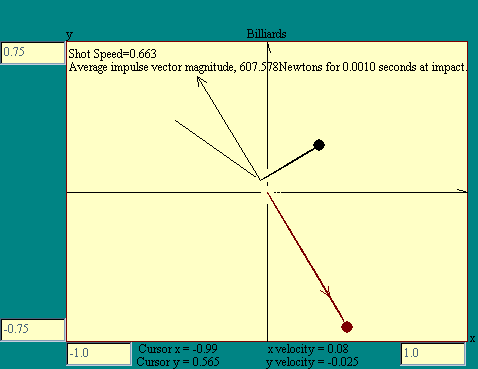
|
This idea that in the absence of external forces the momentum
remains constant is called the principle of the
"conservation of linear momentum". This principle, like
the conservation of energy or work-energy theorem, seems to be
near the heart of the laws of nature. It applies in all kinds of
situations, even those outside the realm of classical
dynamics.
So far we have developed two distinct modeling schemes for
building mathematical models of dynamical systems. In the first
instance we used Newton's second law. The implicit assumption
in using that modeling scheme is that we know what forces are
applied to the particle and how that force varies as a function
of time. The other modeling scheme involved the first fundamental
conservation law we discovered, the conservation of mechanical
energy. In applying that model we need to know the way the
potential energy varies as a function of position. Now that we
have the conservation of linear momentum as another basic
principle we can model some situations in which we know neither
the forces nor the potential field.
One instance of a system where the detail of forces and fields
is obscured is in collisions. It is theoretically possible to
know in detail the way force varies with time in a collision but
as a practical matter that may be very difficult to determine. By
"collision" , I mean an interaction between two objects
which is over is a very short time, compared to the time of
observation. With this as a working definition, we may divide
time up into three regions, before collision, during collision
and after collision. Using the conservation of linear momentum
and the conservation of mechanical energy, we may determine from
the before collision conditions what the conditions will be after
the collision without ever knowing exactly what went on during
the collision.
You may recall one example of a collision
already illustrated in the
Billiards
display. It was used in the discussion of Newton's third law.
I cheated a little bit and used the conservation of linear
momentum in that display before we understood the concept.
Perhaps you would like to review that display with the idea of
conservation of momentum in mind.
|
|
The model behind this display operates on Newton's first
law during the times before and after the collision. We assume
there are no forces on the balls before and after the collision
so the equations of motion are the trivial case of no change in
velocity. During the collision the two balls compress one another
slightly exerting huge forces. Even though we will not work out
in detail the variation of force with time, we can get some
notion of the total force involved.
We know now that f=p'. Lets estimate the
forces involved in a head on, dead center collision between the
two balls of equal mass. The cue ball stops in that case and the
red ball goes off at the velocity that the cue ball had
initially. Verify this with the model or go down to your local
tavern and try it. The way to get a head on collision with the
model is to place the cursor right on the center of the red ball
for the shot. You might want to start with the cue ball at the
far right for maximum shot speed. Let's assume you achieve a
cue ball speed of 2 meters per second. The change in velocity of
the cue ball then is 2m/s since it comes to a complete stop.
A normal cue ball has a mass of about .25kg so the momentum
change is .25*2kgm/s = 0.5kgm/s. The question now becomes, how
long does it take for the cue ball to stop. Here is where we have
to estimate a number. Let's say the balls remain in contact
for 1e-3 seconds. The average force magnitude |f| then during the
1e-3 seconds is |f| = p' = .5/1e-3 = 500 Newtons
This is considerable force, perhaps enough to lift a small
adult off the ground. Forces of the sort we are talking about
here, large but short are called "impulse" forces.
Impulse forces even though of short duration can do considerable damage to the objects involved. In
general they are estimated by dividing a change in momentum by
the time to make the change. Conversely the average force if
known, multiplied by the time the collision lasts is called the
impulse of the force and is equal to the change in momentum.
|

|
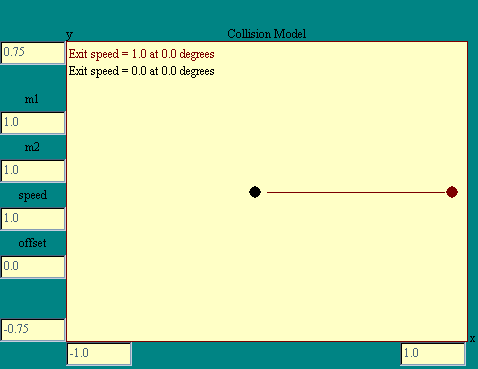
|
The basis for our collision model will be the two conservation
principles, conservation of kinetic energy and conservation of
linear momentum. We can work with conservation of kinetic energy
only, because in studying collisions we want to isolate the
effect of the collision from the effect of other forces. So we
will set up our conditions such that other forces like those
arising from potential energy changes do not apply. Actually
collisions are classified as to whether or not kinetic energy is
conserved. If it is, the collisions are called
"elastic" collisions, if not they are called inelastic
collisions. We are going to limit ourselves to elastic
collisions.
Consider two spherical objects one of mass m1 and
the other of mass m2. Let's set things up so these
objects are approaching each other along the line joining their
centers, a recipe for a head on collision. Let these objects not
be subject to any forces and be not rotating or vibrating. The
motion is purely translation. Under these conditions we may
choose a reference frame which is one dimensional, with the
objects on the x axis.
Applying the conservation of linear momentum to this situation
we have,
m1 * v1i +
m2 * v2i = m1 * v1 +
m2 * v2,
where vi is the initial velocity of each object and v
is the final velocity of each object. The conservation of kinetic
energy gives us the equation
1/2 * m1 *
v1i2 + 1/2 * m2 *
v2i2 = 1/2 * m1 *
v12 + 1/2 * m2 *
v22.
These may be rewritten as follows:
m1 * (v1i -
v1) = m2 * (v2 -
v2i)
for the momentum equation and
m1 * (v1i2 -
v12) = m2 *
(v22 - v2i2)
for the energy.
As long as the difference between final and initial velocities
is not zero for either object (meaning a collision actually
happens), we may divide the second equation by the first one
which yields
v1i + v1 =
v2 + v2i ,
or
v1i - v2i =
v2 - v1.
In other words in a one dimensional elastic collision, the
relative velocity of approach before the collision equals the
relative velocity of separation after collision.
Now here is one of those places where we are going to lean on
that algebra background I told you would need in this course. To
get the final velocities in terms of the initial velocities and
the masses, you would solve the last equation above for
v2 and plug that into the momentum equation and solve
to get
v1 = v1i *
(m1 - m2) / (m1 + m2)
+ v2i * (2 * m2) / (m1 +
m2).
Likewise
v2 = v1i * (2 *
m1) / (m1 + m2) + v2i
* (m2 - m1) / (m2 +
m1).
So we have the basis for a model of a one-dimensional elastic
collision. For initial conditions v1i and
v2i, if a collision happens, the final velocities
depend on the masses as above. In the special case where the objects
have the same mass and object 2 was initially at rest, you can easily see from the equations that object 1 comes to a stop and object 2 takes off with the same velocity object 1 originally had. The objects just exchange velocities.
|
|
One-dimensional (head on) elastic collisions though leave a lot of
naturally occurring collisions unaccounted for. We should extend
this model to two dimensions to be more realistic. In three
dimensions the models get too complicated for this online course.
you may try our
Physics_T
runtime book if you need to model up to three-body collisions in three dimensions
In two dimensions the final velocities have two components
each, an x and a y velocity, so here are four unknowns to be
determined. Since momentum is a vector quantity, in two
dimensions, conservation of momentum gives us two equations, one
in x and one in y. Kinetic energy is a scalar quantity so the
conservation of kinetic energy only gives us only one equation,
leaving us one equation short of the number we need to solve for
four unknowns.
What we need here is some additional information. To get that
we have to look at the geometry of the collision itself. Since we
are dealing with spherically symmetrical objects that geometry is
not too hard to work out. The velocity of each ball is a vector
which can be resolved into components one of which is on the line
connecting the centers and the other perpendicular to this line.
At the instant of the collision, the component in the line of
sight, so to speak, will be the only component producing a force
on the other ball. The perpendicular component can not change a
ball's momentum because it does not act through the center of
mass at all (Think about it.) Likewise the collision cannot
change the velocity across the line of sight.
So in a sense all collisions are one
dimensional if the dimension is carefully chosen at the moment of
impact. We can calculate the velocities in the line of sight at
the instant of impact from the initial velocities of the balls.
Then we can apply the one-dimensional analysis to determine what
the velocities in the line of sight will be immediately after the
collision. Next we take the change in line of sight velocities
from before to after the collision, and recognizing that no other
component of the initial velocities will be affected by the
collision, we add this change for each ball to the initial
velocities to get the after collision velocities. Run the
Collision Geometry
display to see the
situation. A bit later you will be able to experiment with
collisions where you will control the masses and the
velocities.
|
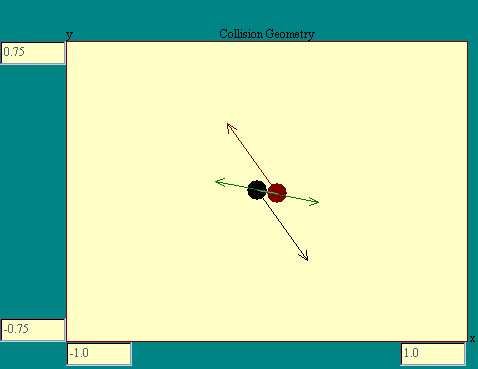
|
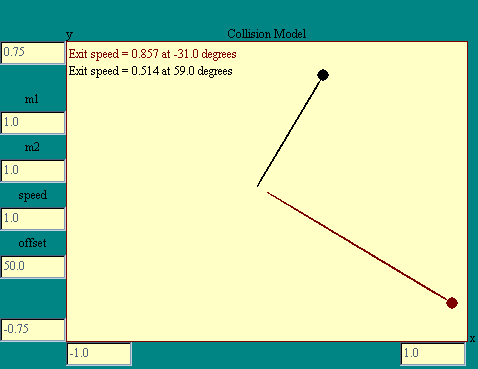
|
Let's just briefly revisit the notion of elasticity. So
far we have been assuming perfect elasticity, meaning that
kinetic energy was conserved. In real collisions, except for some
of those between nuclear particles, the elasticity is less than
100%. For now we will just accept that there may be some loss of
kinetic energy between the before collision and after collision
system. Even a 0% elastic collision does not mean that the
objects come to a stop, they just stick together. So the loss in
kinetic energy can only be as much as is consistent with the
conservation of momentum. I have not been able to write a good
simple model for inelastic collisions. When I solve that problem,
we may be able to go further with this discussion.
Now we can get a bit more precise with a billiard type
display. Actually we are going to use two balls and a box in this
model. Sort of like a billiard table with the possibility of
using a variety of balls in a set up shot. We will not consider
the effect of rotation. My computer is not fast enough to deal
with the math involved in that. Run the
Collision Model display to try out different values of the
mass, speed and directness for two dimensional collisions.
Next we will deal with any rotational motion about the center
of mass.

Are there any questions?
|

 Next
Next
 Previous
Previous
 Other
Other
|




